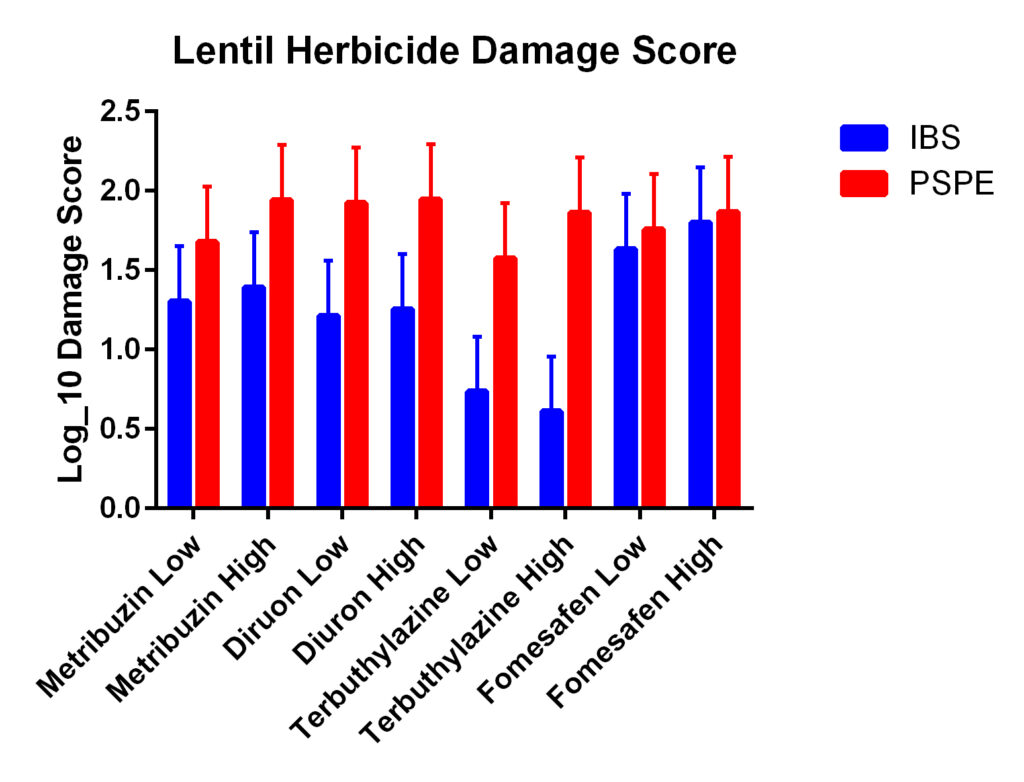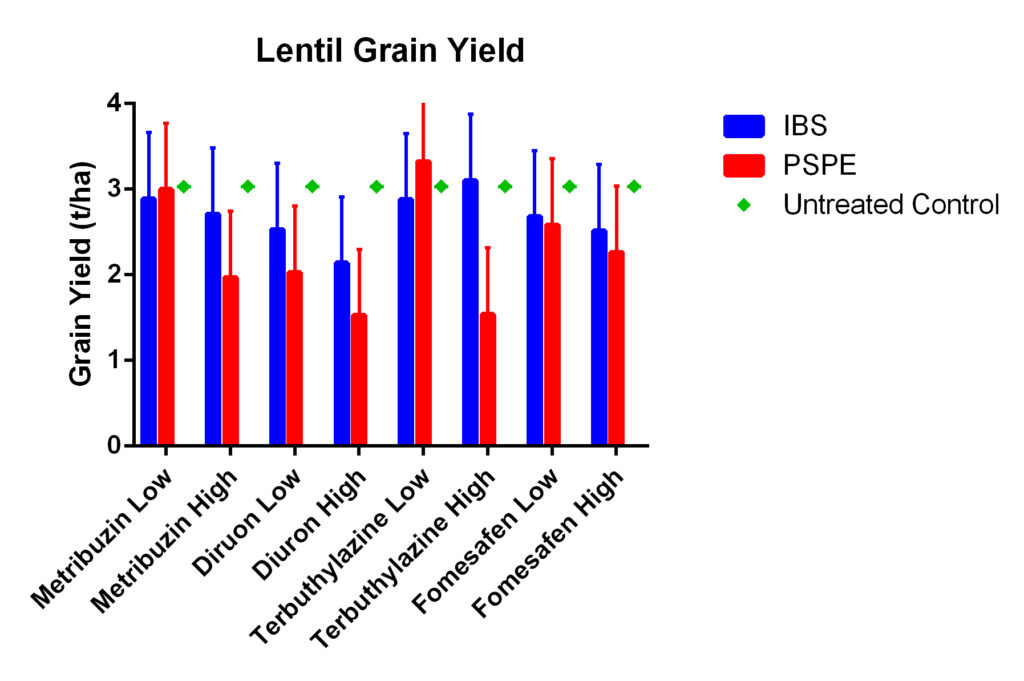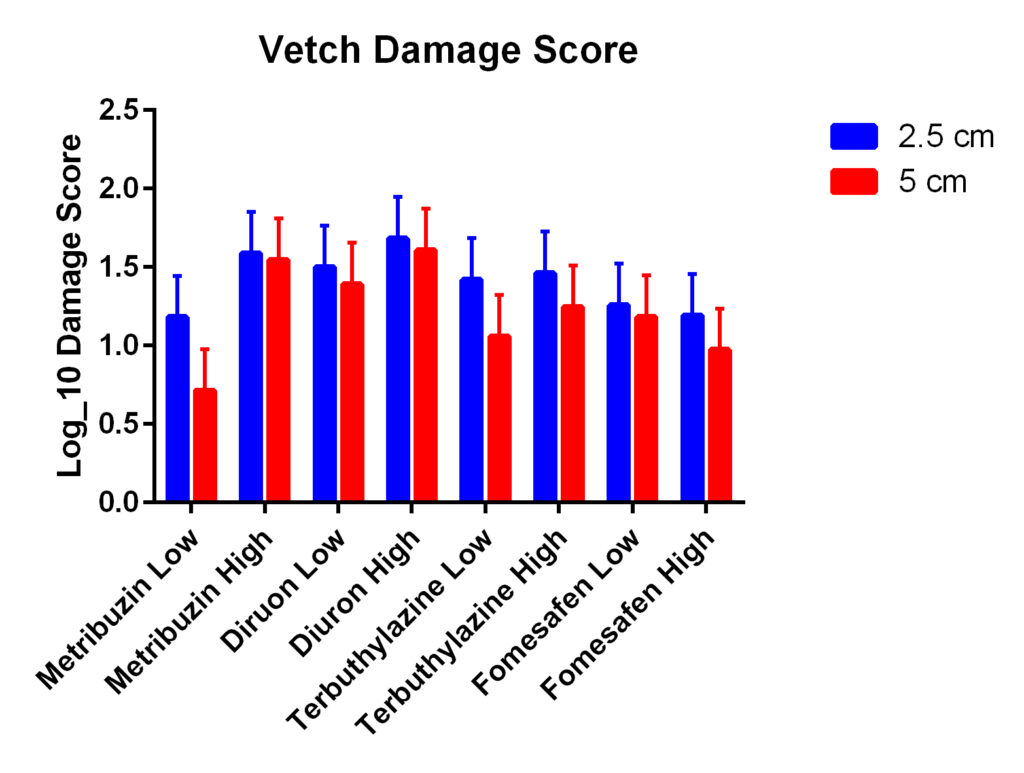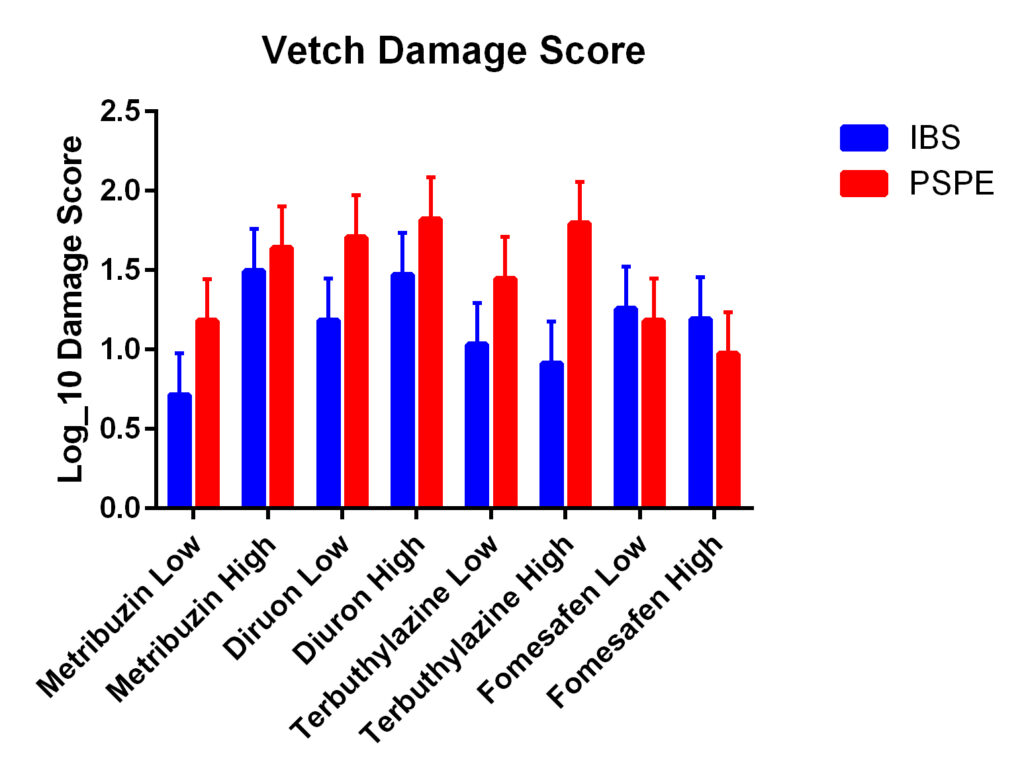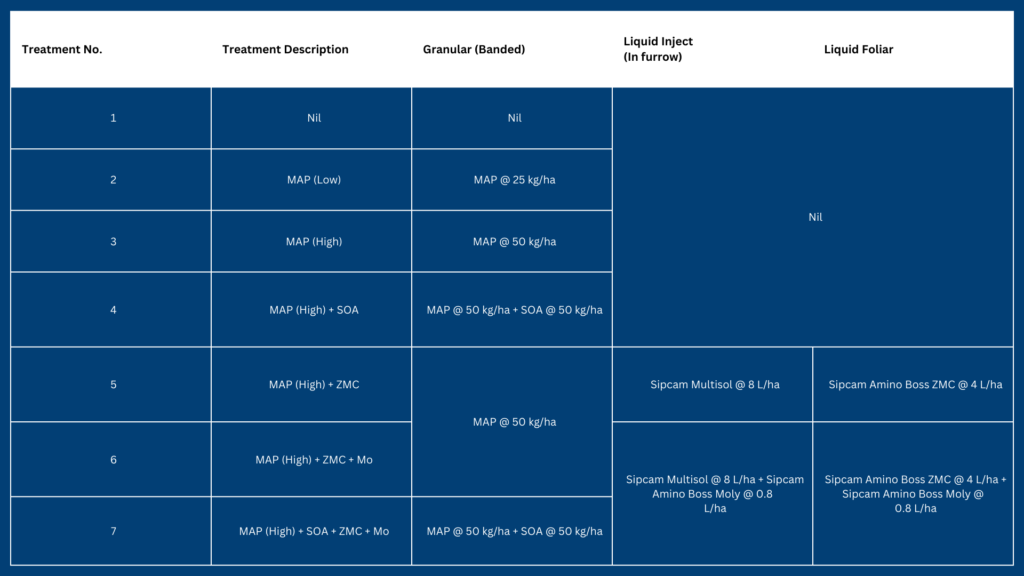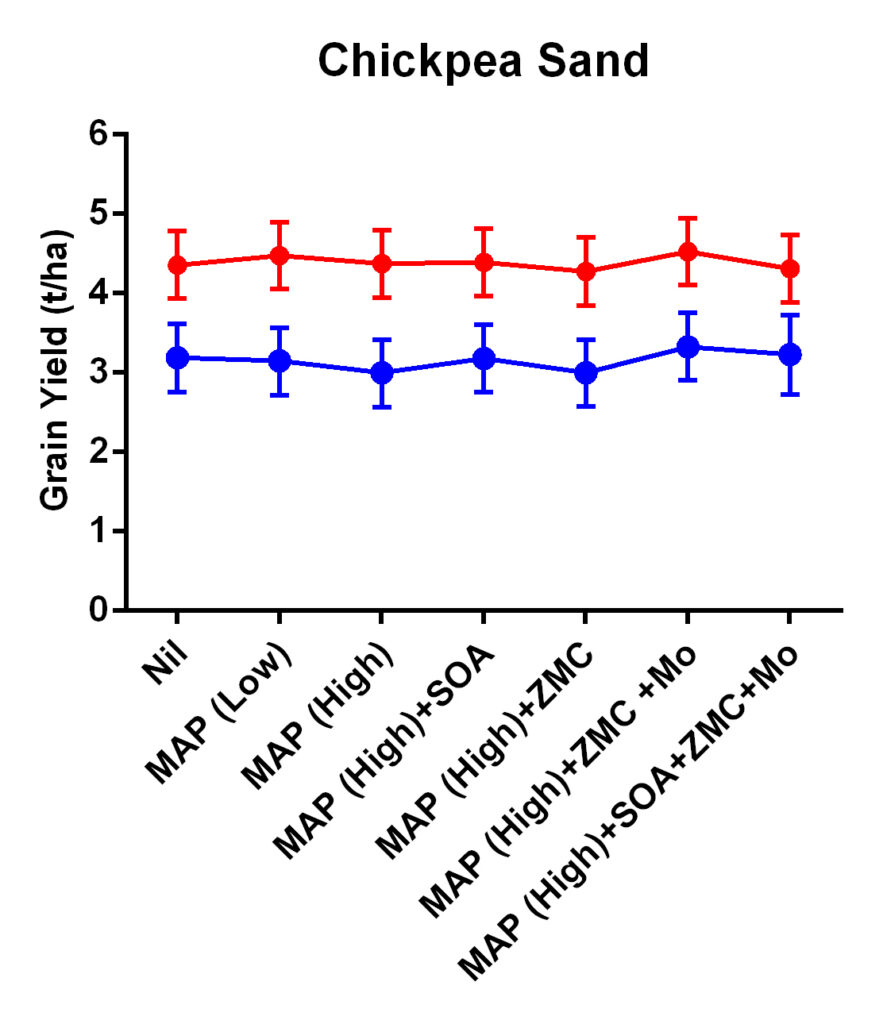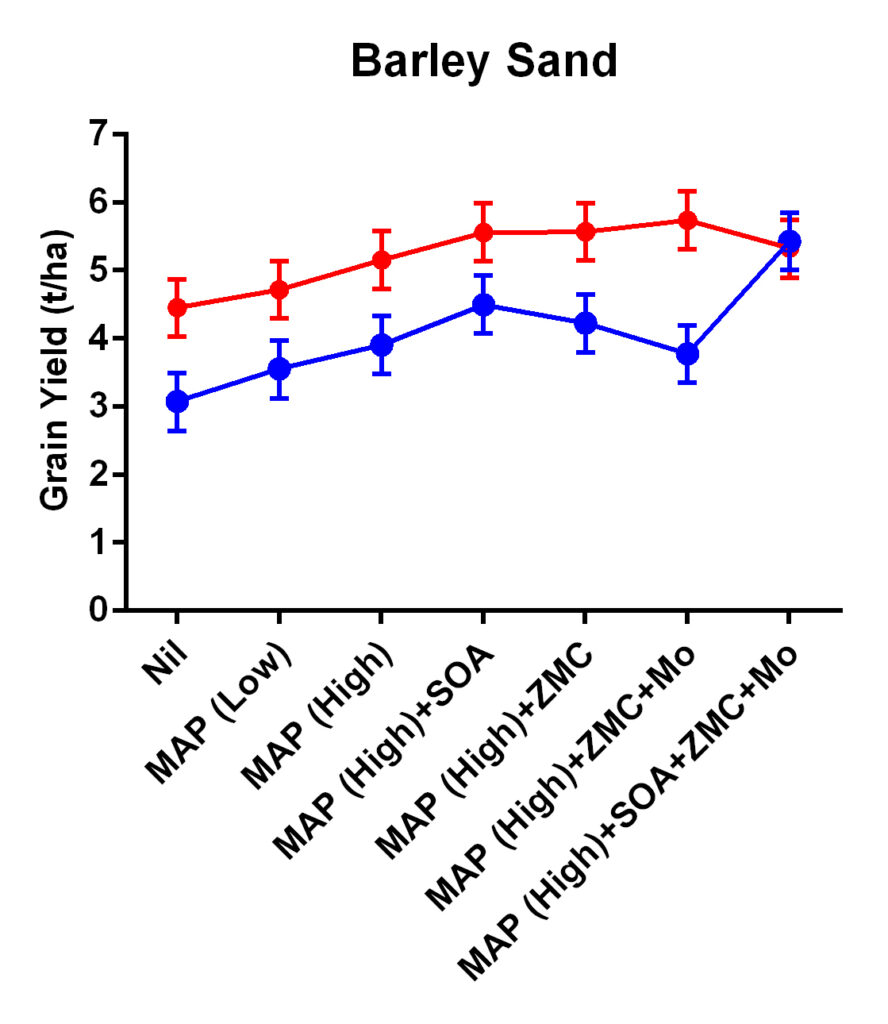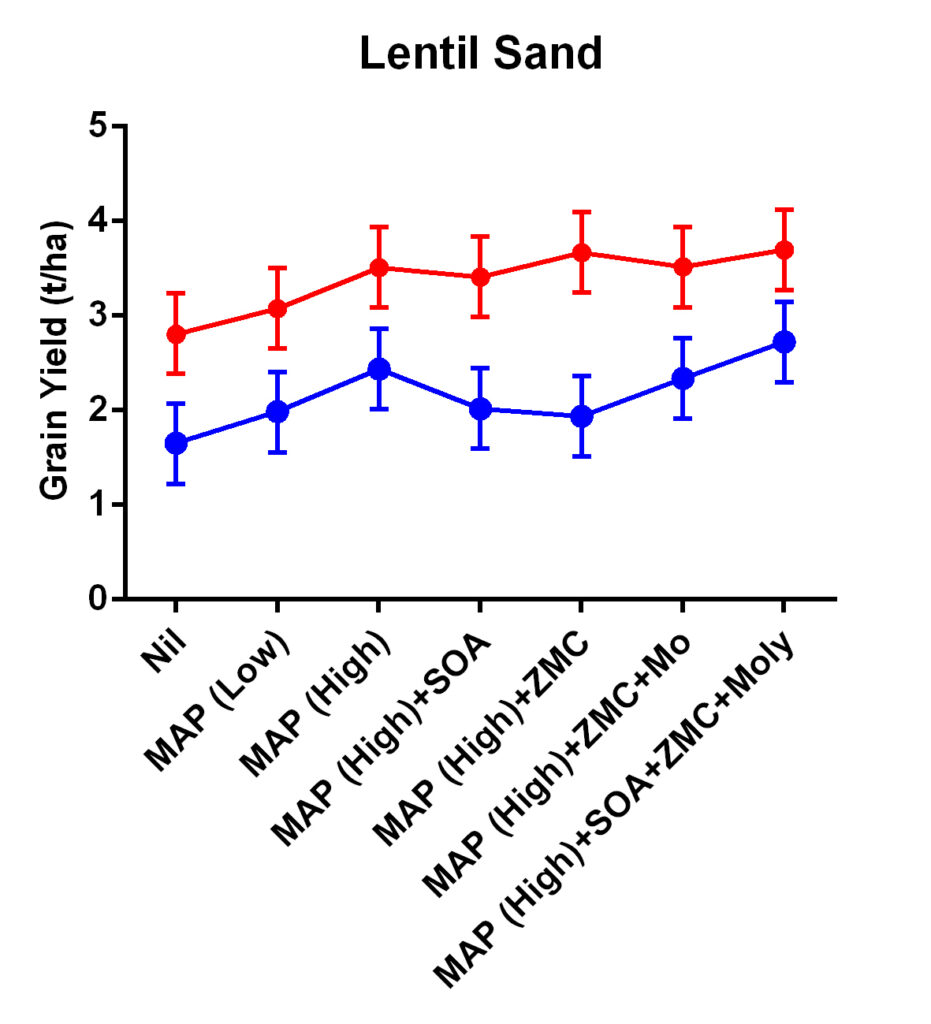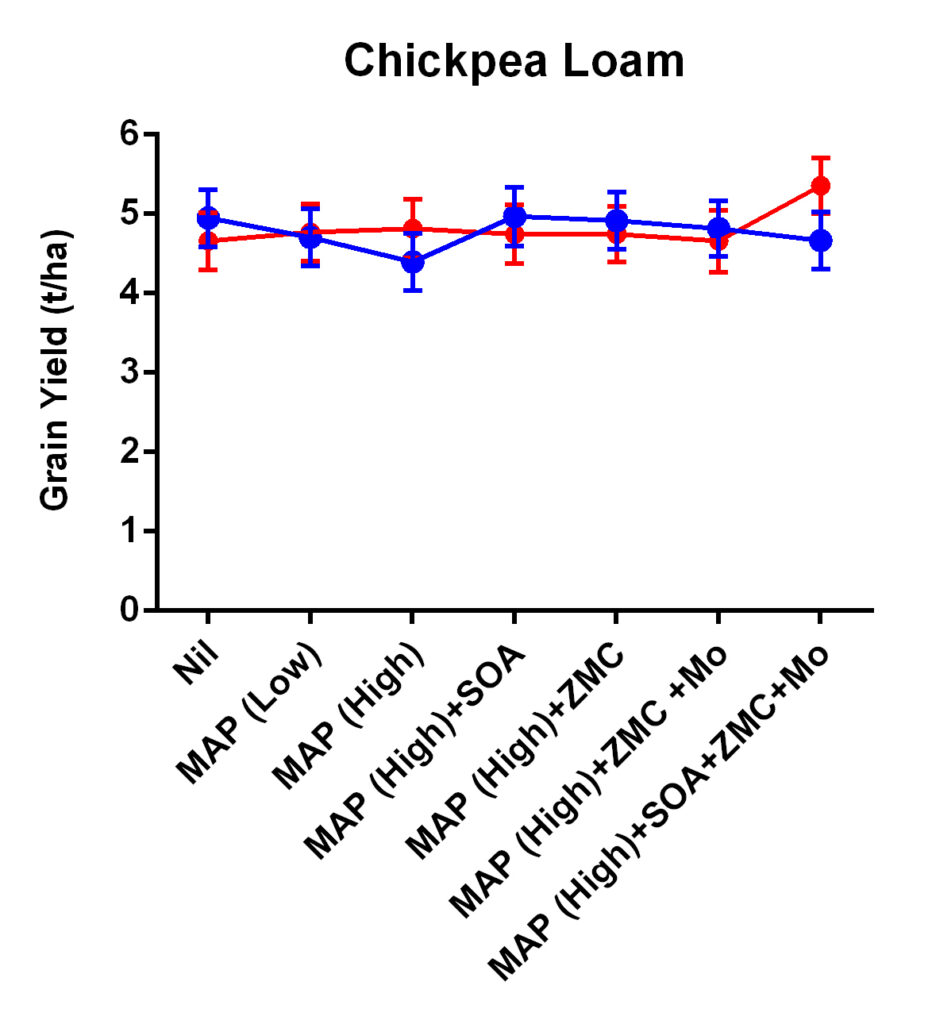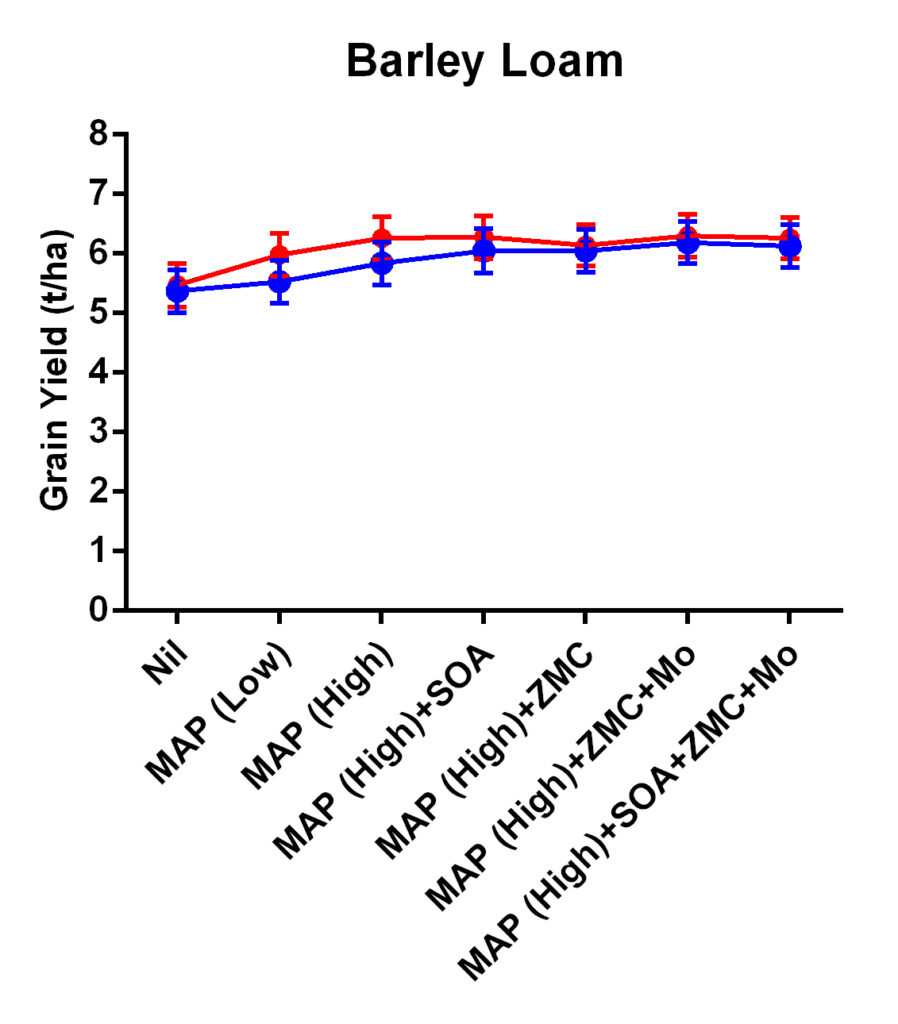Dropzone herbicide, double knocks of summer weeds and opportunities in area wide weed management
Description
Brought to you from the Kyalite Hotel as part of our Mallee Research Update roadshow, we catch up with Research Agronomist Michael Moodie and Field Development Officer with Nufarm, Dave Keetch.
Michael discusses the latest fleabane management trial results from the Area Wide Management of Weeds project and Dave talks about the soon to be released 2,4-D product Dropzone which will provide additional safety for growers when summer spraying weeds.
This podcast was proudly supported by Western Local Land Services and the New South Wales Government’s Environmental Trust and the Australian Government Department of Agriculture, Water and Environment as part of the R&D for profit program in partnership with GRDC, the Cotton RDC and AgriFutures Australia.
Good neighbours stop the spread of weeds
Description
We catch up with Chris Preston in Mildura as part of the Area Wide Management of Weeds project. Glyphosate resistance has been identified as a key issue when managing highly dispersive weeds and taking a ‘good neighbour’ approach to weed management has been identified as a key practice to getting on top of highly dispersive weeds.
In the Sunraysia region we are focusing on fleabane, ryegrass and sow thistle control and the tactics that can help support broadacre cropping and horticultural producers to get on top of these weeds.
For more information about the project visit CSIRO Area Wide Management of Weeds
This project is supported by the Australian Government’s Rural R & D for profit program with co-investment from the Grains Research Development Corporation and the Cotton Research Development Corporation.
Area wide management of pests – it can work!
Description
On this episode host Tanja Morgan is joined by Matt Strmiska, Consultancy Lead with EE Muir Sons who hails from Fresno, California.
Matt has spent a decade of his career working with some of the largest horticultural growers in the region to minimize pesticide use by applying knowledge practically.
In this episode, Matt speaks about his experience with area-wide pest management in the United States and the long-term benefits.
Making pulses work in the Mallee ft. SA Farmers Skeet Lawson & Wade Nickolls
Description
In the latest MSF Farm Talk Podcast we catch up with two Pinnaroo farmers, Wade Nickolls and Skeet Lawson as well as Research Agronomist, Michael Moodie.
Wade and Skeet were involved in the Pinnaroo Pulse Check Group which is part of the GRDC Southern Pulse Extension Project which started in 2017 and has just wrapped up now after 3 years. There were two groups in the Victorian Mallee and two groups in the South Australian Mallee. The Southern Pulse Extension Project is proudly funded by GRDC, executed by MSF and led by Birchip Cropping Group.
In the second half of this episode, we caught up with MSF’s Key Research Agronomist, Michael Moodie, Frontier Farming Systems. Michael has been carrying out lots of research work across the Mallee and facilitating the Millewa Pulse Check Groups.
The Pulse Check groups allowed growers to network and compare their experiences, challenges and findings in their local area plus share practical knowledge to bridge gaps where research in the low-rainfall zone is lacking when it comes to pulses. Attendees varied between experienced pulse growers and those new to growing pulses in the Mallee.
NSW strategies and paddock restoration experience after drought
Description
In this episode, Chris McDonough visits cousins Nigel Baird and Peter Baird in a paddock badly drifting in the 2018 and 2019 drought.
They’re talking about the GRDC investment ‘Practical tactics to improve ground cover and ensure soil preservation following successive low rainfall seasons.’
The Baird’s is a remarkable story of recovery. Following an extended period of drought, which in itself is bad enough, thousands of kangaroos descended from station country to take away any remaining ground cover, and this caused devastating wind erosion.
Since then Nigel and Peter have been working really hard to get the paddock back to where it was before the drought. Their success now just goes to show what can be done with a bit of hard work and determination.
To view the case studies from the project visit the GRDC website click here
To view the podcast transcript click here
Understanding soil compaction in the Mallee
Description
In this episode we unpack compaction! If you’re considering deep ripping paddocks this year do you know where to test or where to start and stop the ripping operations?
We’ve asked the experts, Research Scientists Therese McBeath and Rodrigo de Silva, the following questions:
- Where do we measure compaction in the paddock and what tools do we need?
- How deep do we need to rip to break up compaction?
- What is the difference between compacted, cemented and hard setting soil and what does this mean for ripping operations?
- Is Controlled Traffic Farming an alternative or complimentary option to deep ripping?
- Fertiliser is expensive, how much do we need to feed ripped areas this year?
A penetrometer is a great tool to have on farm if you are planning on deep ripping. For a small investment you can monitor the compaction in your paddocks and monitor the success and longevity of your ripping operations.
A simple to use penetrometer can be purchased online at https://bit.ly/3GseNMf
Seeding with success following soil amelioration
Description
In our latest podcast, special guest host Pru Cook, from Nine Creeks Consulting, catches up with Michael Moodie to discuss the hot topic of seeding successfully in a an area of the paddock that has had soil amelioration.
Michael discusses the potential pitfalls and highlights important steps to consider when seeding into ameliorated areas including tackling sinking, ensuring even crop establishment and what additional inputs that may be required.
For the latest info on soil amelioration and managing Mallee soils, jump on to the ‘Managing Mallee Soils’ Facebook discussion page where the topic of soil amelioration has been featured extensively as well as understanding soil constraints, soil testing and managing ground cover.
The ‘Managing Mallee Soils’ group is supported by FRRR with funding through the Australian Government’s Future Drought Fund.
Improving the grain yield of lentils and chickpea grown on Mallee sands
About the Trial
A trial site was established near Ouyen in the Victorian Mallee on a deep sand dune soil. Deep ripping was undertaken in April to a depth of 50cm. The deep ripper was fitted with Tilco A66 tynes spaced at 56 cm apart. Crops were sown on two dates: 2nd May and 1st June 2022. At each sowing time four varieties of Chickpeas and Lentils were sown (Table 1)
| Chickpea Varieties | Lentil Varieties |
|---|---|
| Genisis 090 | PBA Bolt |
| CBA Captain | GIA Lightning |
| PBA Hatrick | PBA Jumbo2 |
| PBA Magnus | GIA Leader |
Seasonal Conditions
Timely crop establishment was achieved with over 100 mm falling during the critical April – May sowing window. The site experienced a relatively dry winter period with just 60 mm of rainfall recorded from June to August. Extremely high levels of rainfall were received during spring with 300 mm of rain falling from September to early November with 126 mm of this received during October. Due to the sandy texture of the soil, waterlogging was not a problem, however the growing season was extended three weeks longer than normal. This made disease control difficult, and some level of disease was present in the crop.
Results: Lentil
Deep ripping increased lentil grain yield by 0.7 t/ha (Figure 1). The grain yield of PBA Bolt was 0.7 t/ha less than the other varieties included in the trial. As a single factor, delayed had only a minor impact chickpea grain yield in the very wet 2022 season.
When all three factors were combined there was a yield gap of 2 t/ha between the best and worst treatments (Figure 2). PBA Bolt sown early without deep ripping resulted in the worst yield outcome of the trial (0.4 t/ha), while late sown PBA Jumbo2 with deep ripping produced the best grain yield (2.4 t/ha.)

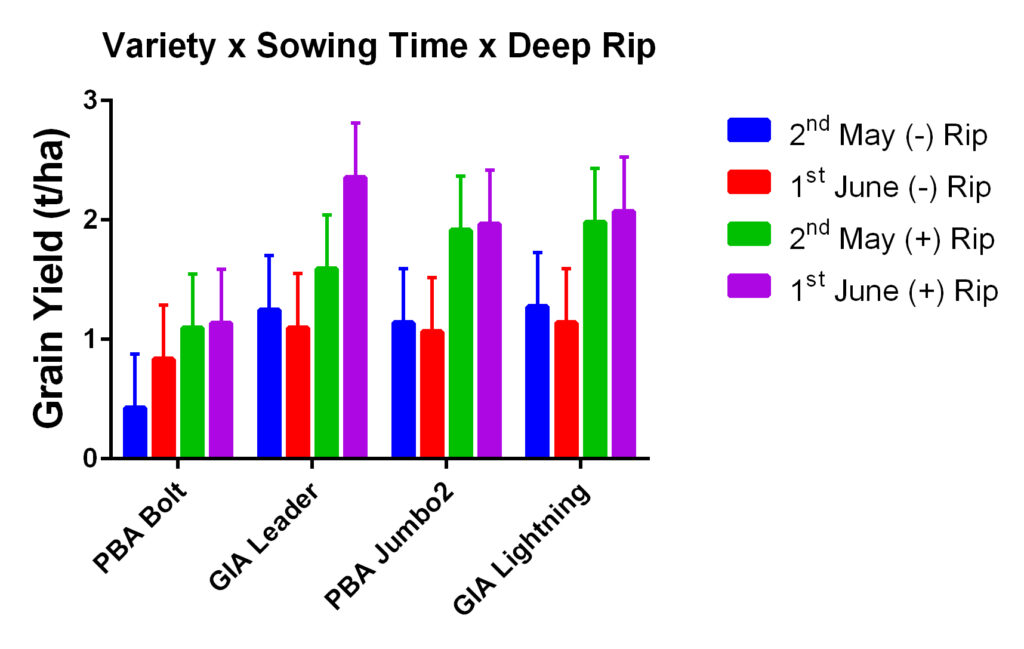
Results: Chickpea
Deep ripping increased chickpea grain yield by 0.7 t/ha (Figure 3). Desi varieties CBA Captain and PBA Hattrick had a 0.6 t/ha advantage over the Kabuli varieties Genesis 090 and PBA Magnus. As a single factor, delayed had only a minor impact chickpea grain yield in the very wet 2022 season.
When all three factors were combined there was yield gap of 1.6 t/ha between the best and worst treatments (Figure 4). For example, sowing Desi chickpeas early following deep ripping resulted in a grain yield of 2.9 t/ha while sowing Kabuli chickpeas late into un-ripped soil resulted in a grain yield only 1.3 t/ha.

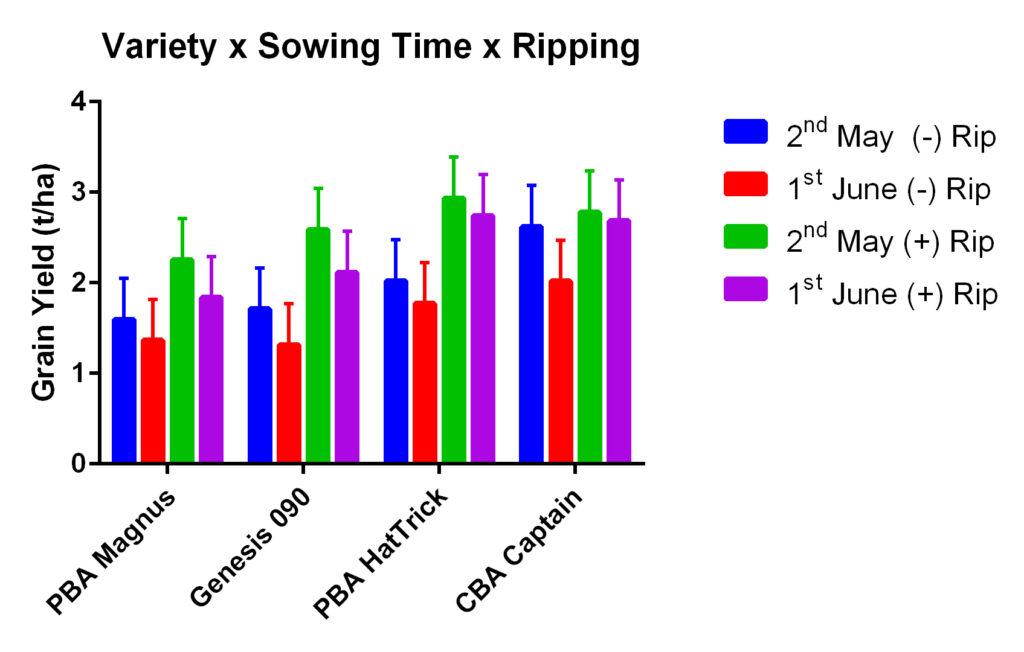
Acknowledgements
This virtual field day has been developed as part of the Mallee Sustainable Farming (MSF) project:
“Facilitating enhanced knowledge sharing of Mallee sustainable farming practices”
This project is supported by the Mallee Catchment Management Authority, through funding from the Australian Governments’ National Landcare Program.

Lentil Variety, Time of Sowing and Seeding Rate
About the Trial
Six commercial lentil varieties were sown at Loxton in 2022 (Table 1). Each variety was sown at three seeding rates to target plant populations of 60, 90 plants and 120 plants m2. Each treatment combination was sown at two Times of Sowing (TOS): 5th May and the 26th of May.
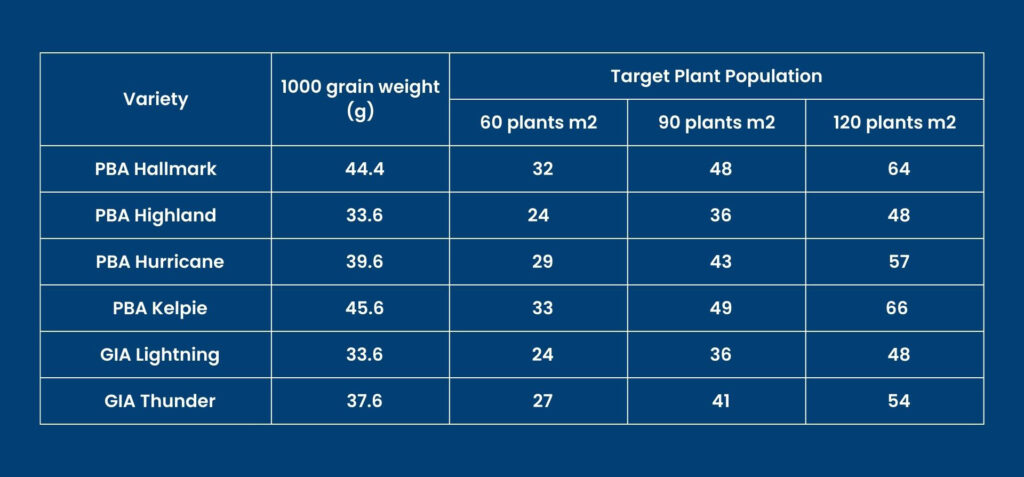
Results
Crop emergence
The emerged plant population was 20-25% higher than the target population for all plant density treatments (Table 2). Seeding rates were calculated using a field germination rate of 80%, therefore most of the planted seeds emerged. This is most due to the excellent soil moisture present at both sowing times following 88 mm of rainfall falling in April-May. There was no difference in emergence between varieties within each target plant population. There was also no difference in lentil emergence between the two sowing times.
| Target plants m2 | Emerged plants m2 |
| 60 | 76 |
| 90 | 112 |
| 120 | 143 |
Grain Yield
GIA Thunder was the highest yielding variety, with an average yield of 4.2t/ha across all treatments (Figure 1). The grain yield of GIA Thunder was significantly better than the other five varieties at TOS 1 and was superior to all varieties except GIA Lightning at TOS 2. PBA Kelpie had the lowest grain yield of all varieties at TOS 1, however it produced similar yields to the other varieties except GIA Thunder at TOS 2 (Figure 2)
Time of sowing generally had no impact in lentil yield in 2022 at Loxton, due to the very wet and cool spring which extended the growing season. The target plant population did effect grain yield, but only at TOS 2. Lentil grain yield increased in linearly from 3.3 t/ha for 60 plants m2 to 3.9 t/ha for the 120 plants m2 treatment at the later sowing date.
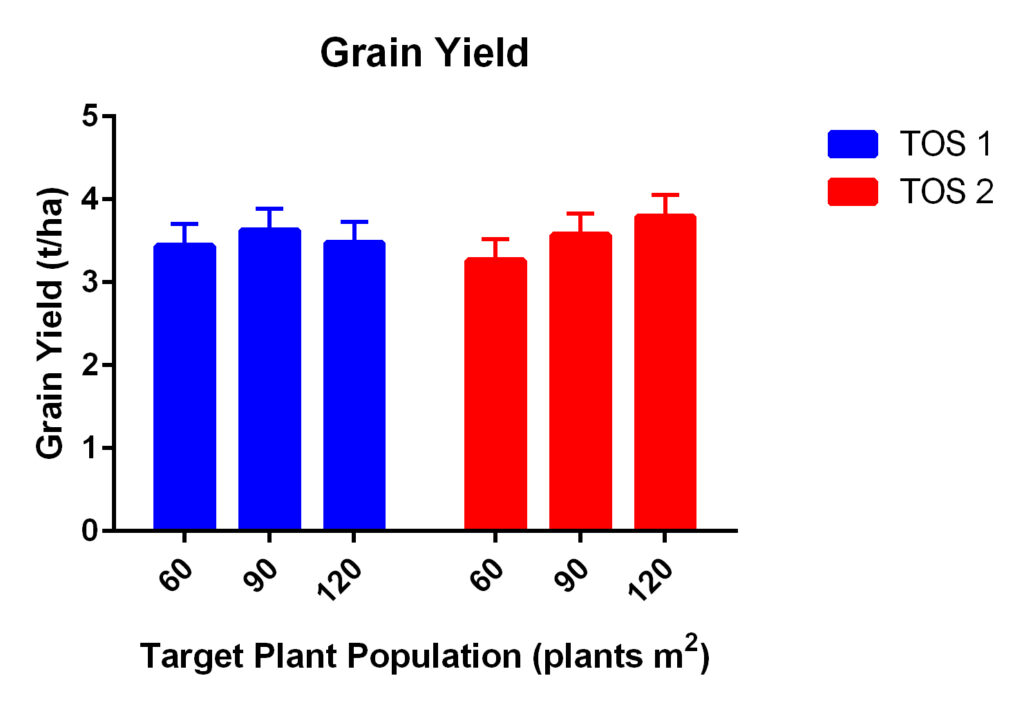
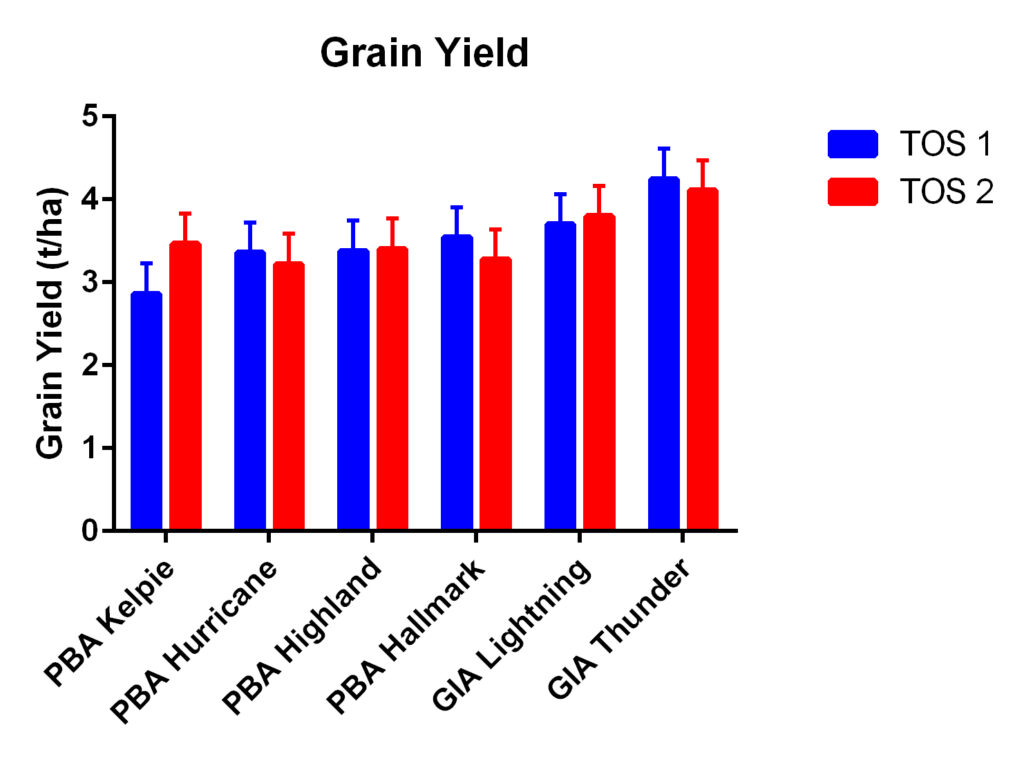
Grain Losses
Grain losses were greater with earlier sowing with 2.5 times more pods dropped and 3.2 times more seed shattered in the TOS 1 than in the TOS 2 treatments. The greatest seed losses were measured in PBA Kelpie, which experienced particularly bad seed shattering (Figure 3). Seed losses via pod drop were also higher in PBA Kelpie than in the other lentil varieties. GIA lightning had lower seed shatter than other varieties, however pod drop was similar between all varieties with the exception of PBA Kelpie.
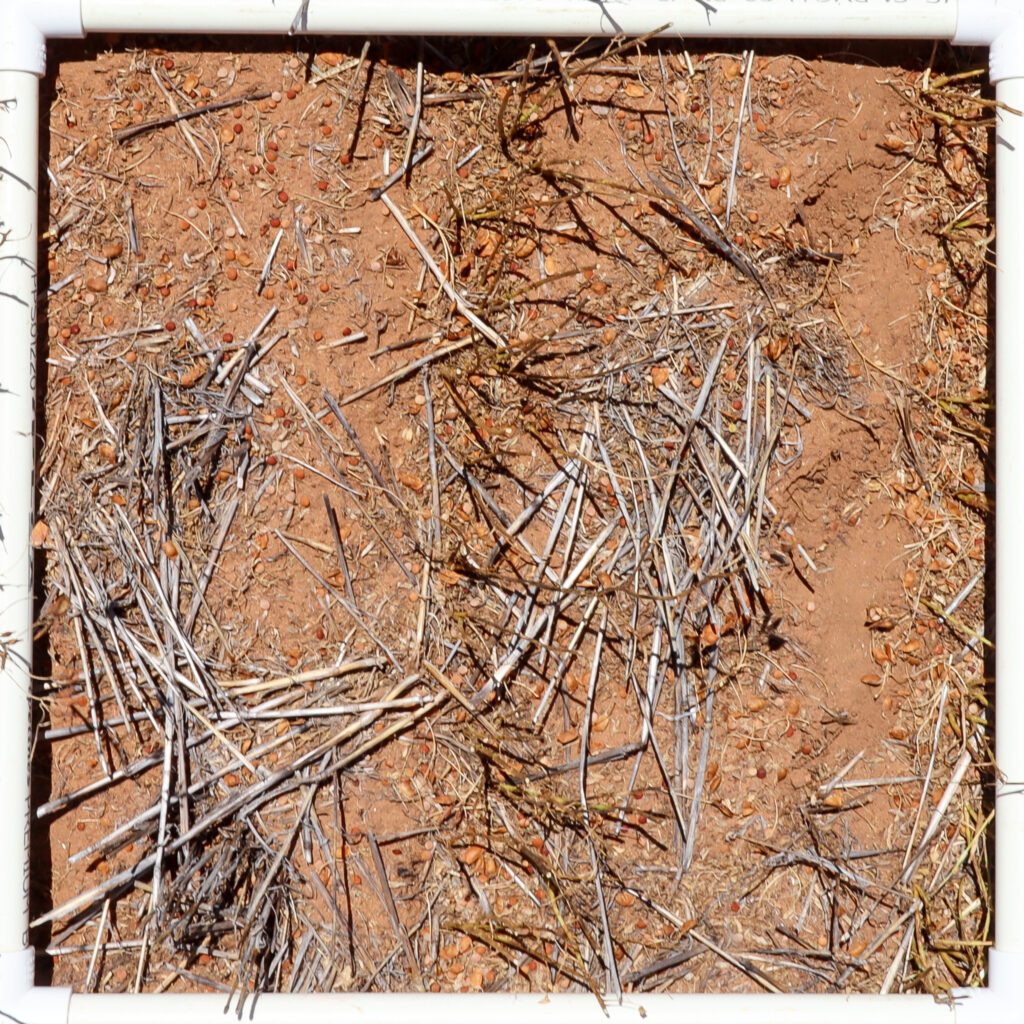
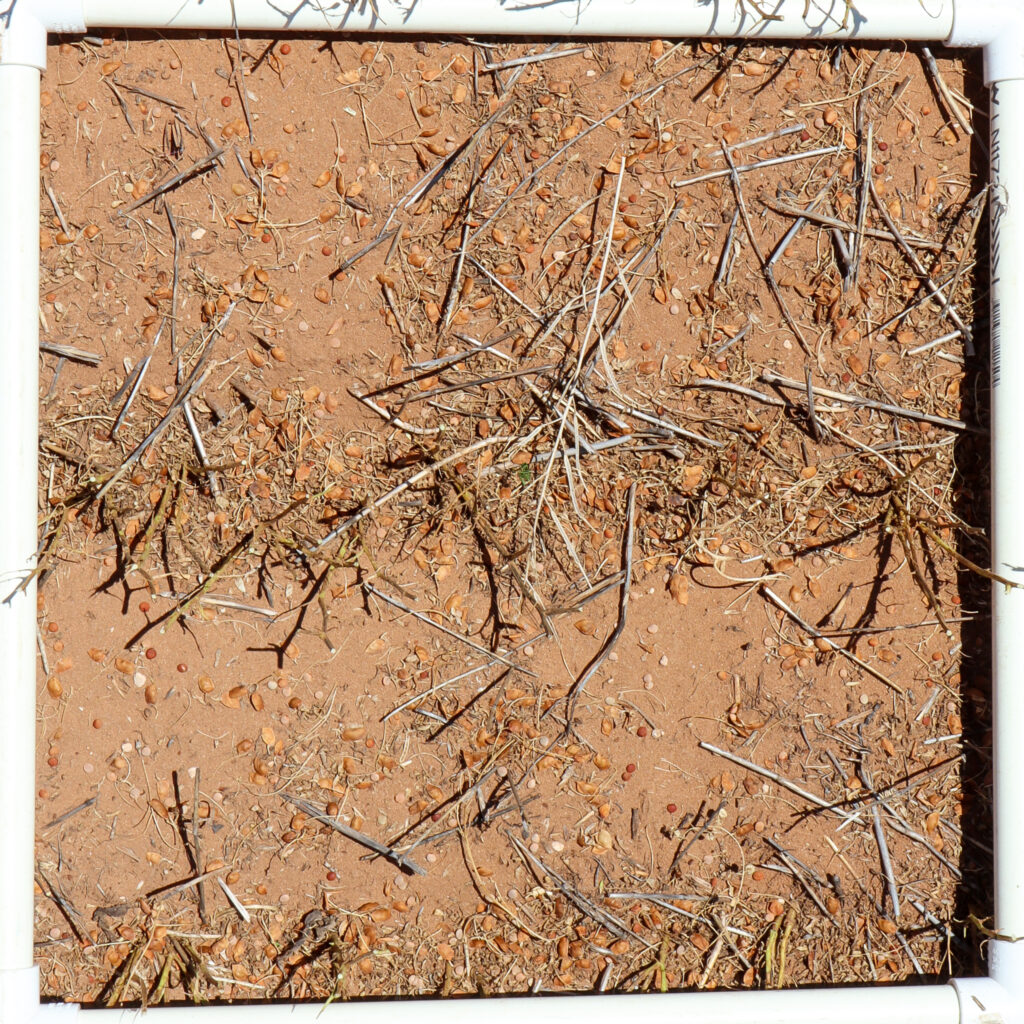


Acknowledgements
This virtual field day has been developed as part of the Mallee Sustainable Farming (MSF) project:
“Facilitating enhanced knowledge sharing of Mallee sustainable farming practices”
This project is supported by the Mallee Catchment Management Authority, through funding from the Australian Governments’ National Landcare Program.

Lentil and vetch pre-emergent herbicide application
About the Trial
Pre-emergent herbicides were applied on 4th May 2022 prior to sowing vetch (Timok) and lentils (GIA Lightning) at Loxton (Table 1).
Each herbicide was applied at a district application rate or double the standard district rate (high) and are summarized in Table 1. Herbicides were also applied as either an Incorporated By Sowing (IBS) or Post Sowing Pre-Emergent (PSPE) application. Both crops were also sown either shallow (approximately 2.5 cm) or deep (approximately 5 cm) depth.
| Herbicide | Herbcide Group | Low Rate | High Rate |
| Untreated Control | N/A | N/A | |
| Metribuzin (750 g/kg) | 5 | 130 g/ha | 260 g/ha |
| Diuron (900 g/kg) | 5 | 400 g/ha | 800 g/ha |
| Terbuthylazine (875 g/kg) | 5 | 430 g/ha | 860 g/ha |
| Fomesafen (240 g/L) | 14 | 0.5 L/ha | 1 L/ha |
Results
The trial was implemented into a moist seedbed with approximately 30 mm of rain falling in the month prior to sowing. A further 50 mm of rain was received in the four weeks post sowing. Furthermore, 275 mm of rainfall occurred during the critical spring period which coincided with flowering and podding, extending the growing season of both crops by approximately three weeks later than normal . The protracted growing season may have allowed for some compensatory growth where early crop damage occurred.
Lentils
The application method of how herbicide was applied had the greatest impact on the level of damage to lentils. Herbicide damage assessments completed six weeks post sowing showed that applying group 5 herbicides IBS (Metribuzin, Diuron, Terbuthylazine) was less damaging than when they were applied PSPE (Figure 1). Terbuthylazine (e.g. Terbyne Extreme®) applied IBS caused significantly less damage than the other herbicides.
Based on the 6 week assessment, the level of damage was similar between all herbicides when applied PSPE. Fomesafen (Reflex®) which is a group 14 herbicide, showed high and equivalent levels of damage irrespective of being applied IBS or PSPE. The depth of seeding of the crop (2.5 cm or 5 cm) did not have a significant effect on the level of herbicide damage to lentils in 2022.
There was no grain yield penalty when each herbicide was applied IBS at the at the lower rates (Figure 2). However, a PSPE application of diuron at the low rate or applying any herbicide PSPE at the high rate resulted in a yield penalty of between 25 – 50%. There was not any effect of sowing depth on lentil grain yield in 2022.
Vetch
Early damage symptoms in vetch were also minimized where Group 5 herbicides (Metribuzin, Diuron, Terbuthylazine) were applied IBS rather than PSPE (Figure 3). Damage symptoms were highest where metribuzin, diuron and terbuthylazine (Terbyne Extreeme ®) where applied PSPE at high rates. Similar to lentils, Fomesafen (Reflex ®) exhibited similar levels of damage when applied through IBS or PSPE at either low or high rates.
Deeper sowing of vetch (5 cm) slightly reduced damage symptoms relative to sowing shallow (2.5 cm) when metribuzin and terbuthylazine were applied at low rates (Figure 4). However, sowing depth did not affect the level of damage observed for the other herbicide treatments.
Dry matter yield penalties were highest where Metribuzin, Diuron, Terbuthylazine were applied PSPE at the high rate (Figure 5). In these treatments dry matter production was reduced by 35 – 40%.

Acknowledgements
This virtual field day has been developed as part of the Mallee Sustainable Farming (MSF) project:
“Facilitating enhanced knowledge sharing of Mallee sustainable farming practices”
This project is supported by the Mallee Catchment Management Authority, through funding from the Australian Governments’ National Landcare Program.

Nutrition x Deep Ripping in lentils, chickpeas, and barley
About the Trial
The trial compared nutritional treatments for lentil, chickpea and barley grown on a sandy soil with and without deep ripping. There were 7 nutrient treatments (Table 1) applied to the following varieties:
- Lentil: GIA Lightning
- Chickpea: Genesis 090
- Barley: Titan AX
Barley plots also received 70 kg/ha UAN (~30 kg N/ha) applied in crop at early tillering.
All nutrient x crop treatments were applied to plots with and without deep ripping. The soil was ripped to a depth of approximately 50 cm using Tilco straight shank tynes.
The trial was replicated on two soil types within the paddock: A deep sandy soil located on the top of a dune, and a sandy loam soil located in the swale between sandy dunes. Soil properties for each soil can be found here
Results
Deep ripping had the biggest impact on the productivity of lentils, chickpea and barley grown on the sandy soil. The benefit from deep ripping was consistent across all three crops with an extra 1.2 t/ha of grain grown following deep ripping. However, on the loam soil, deep ripping was not beneficial in any crop.
There were some small benefits from nutrition treatments, however these effects were mixed in terms of crop type and soil type. There was approximately 0.7 – 0.8 t/ha grain yield response from applying 50 kg/ha MAP relative to the nil fertiliser treatment in lentils and barley. The rate of response was similar across both soil types, which equated to a rate of return of approximately 15 kg/grain for each one kilogram of MAP applied. In barley, the addition of sulphate of ammonia (SOA) also improved grain yield, but only on the sandy soil type.
The application of trace elements alone did not influence the productivity of any crop or soil type. However, when trace elements were applied in combination with SOA to barley on the un-ripped sandy soil, this combination produced superior grain yields to all other nutrition treatments. This complete nutrition package also closed the yield gap between ripped and un-ripped soil. However, given the extremely high growing season rainfall experienced at the site in 2022, it is probable that barley yields were nitrogen limited. Grain protein levels in barley were 10 – 10.5% which further indicates grain yields reached a nitrogen limited yield potential, which possibly capped the yield benefit achieved by deep ripping in barley.
Acknowledgements
This virtual field day has been developed as part of the Mallee Sustainable Farming (MSF) project:
“Facilitating enhanced knowledge sharing of Mallee sustainable farming practices”
This project is supported by the Mallee Catchment Management Authority, through funding from the Australian Governments’ National Landcare Program.



